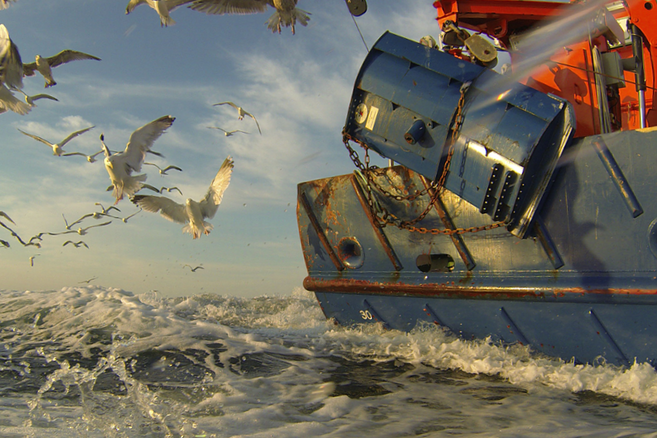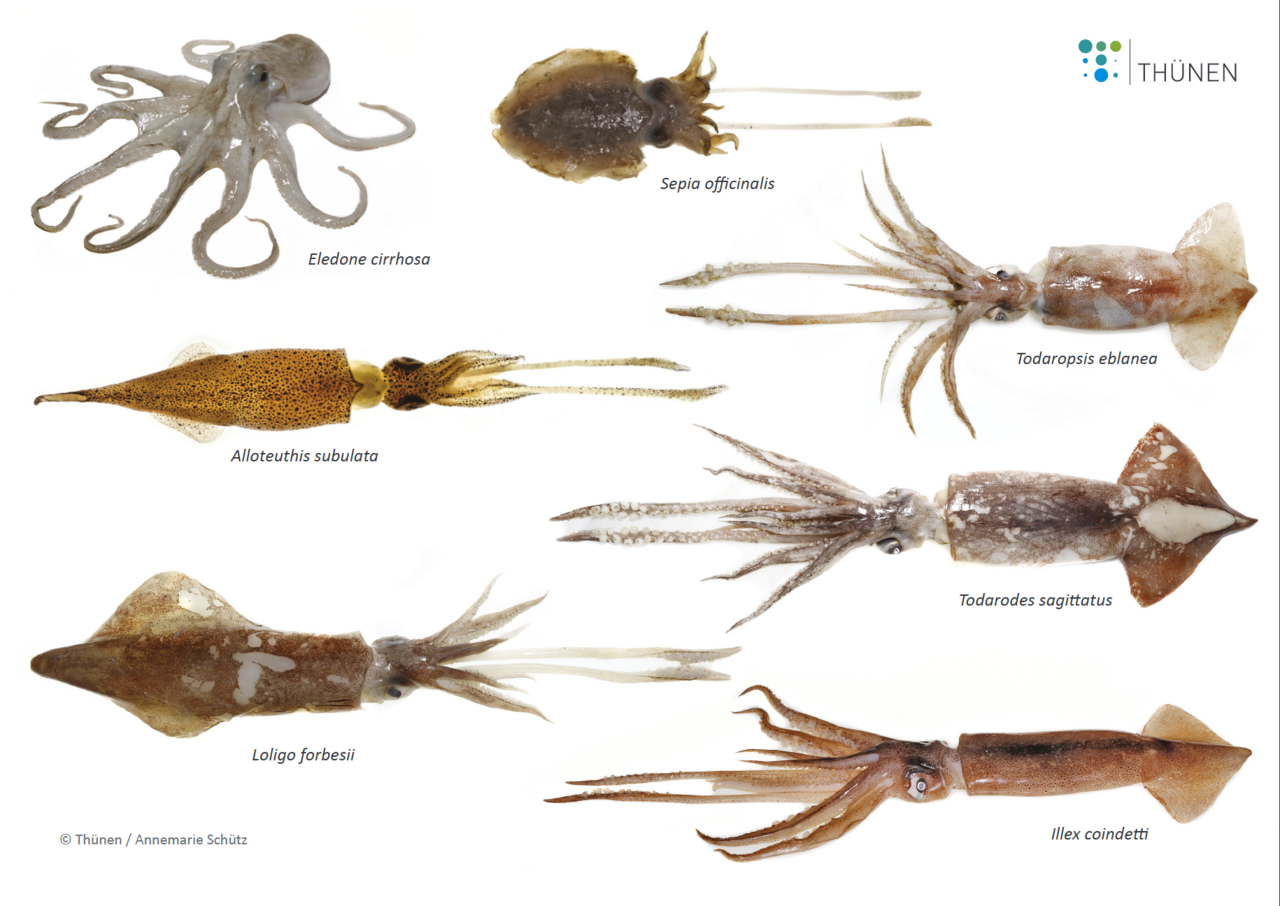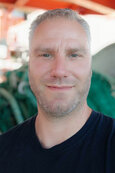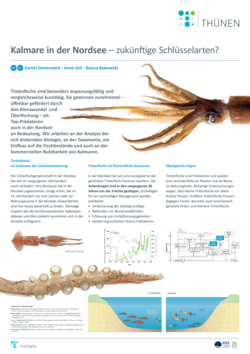

Institut für
OF Ostseefischerei
Projekt
Wie verändern sich die Tintenfischbestände und was sind die Konsequenzen?

Tintenfische im fischereilichen Kontext
Kalmare, Kraken und andere Tintenfische gehören zu der Klasse der Cephalopoden, die gemeinsam mit Schnecken und Muscheln dem Tierstamm der Weichtiere (Mollusca) zugeordnet werden. Der Name Tintenfisch ist somit irreführend und müsste eigentlich durch Tintenschnecke ersetzt werden.
Die für die meisten Muscheln und Schnecken typische Schale ist bei dieser Tiergruppe reduziert oder gar weggefallen. Der Fachbegriff Cephalopoda lässt sich aus dem griechischen (kephalos = Kopf; podos = Fuß) herleiten. Cephalopoden gibt es seit schätzungsweise 500 Millionen Jahren. Sie leben marin und im Brackwasser. Es gibt keine Süßwasser- oder terrestrischen Formen. Allerdings sind sie in fast allen Meeren und allen Tiefen vertreten. Manche Arten leben pelagisch (Freiwasserbereich) andere leben benthisch (Bodenbereich). Alle Kopffüßer haben gemein, dass sie sich räuberisch hauptsächlich von anderen Weichtieren, Krebsen und Fischen ernähren.
Hintergrund und Zielsetzung
In den letzten Jahren konnten verschiedene Veränderungen im marinen Ökosystem aufgrund von Klimaveränderungen festgestellt werden. So haben sich beispielsweise der Lebenszyklus oder die Verbreitungsgebiete einiger Fische verändert. Tintenfische scheinen in vielen Gebieten von den klimatischen Veränderungen zu profitieren, da die Tiere neue Gebiete besiedeln und ihre Biomasse angestiegen ist. Dies hat zur Folge, dass die Tiere auch für die Fischerei in einigen Bereichen interessant geworden sind. Allerdings gibt es derzeit fast keine Bewertung der europäisschen Bestände, und auch fast keine Fischereibeschränkungen der Tiere. Wir dokumentieren daher die Veränderungen der Tintenfischfauna, analysieren deren Auswirkungen auf das Ökosystem und erarbeitet die wissenschaftliche Grundlagen für eine nachhaltigen Nutzung.
Vorgehensweise
Zur Dokumentation der Veränderungen der Tintenfischfauna nutzen wir unsere regelmäßig durchgeführten standadisierten Seereisen bei denen die Tintenfische als Beifang dokumentiert werden.
Die Auswirkungen, einer sich verändernden Tintenfischfauna, werden aktuell über die Position der Tintenfische innerhalb des Nahrungsnetz bestimmt. Tintenfische gelten als wichtige Nahrungsressource für viele Räuber, sind aber auch selbst aktive Prädatoren.
Um ein nachhaltiges Management zu entwickeln testen wir verschiedene Methoden um die Populationsstruktur und Bestandseinheiten zu definieren. Zudem untersuchen wir den Lebenszyklus und die Biologie dieser einzigartigen Tiere.
Links und Downloads
Thünen-Ansprechperson

Thünen-Beteiligte
Zeitraum
Daueraufgabe 1.2019 - 12.2028
Weitere Projektdaten
Projektstatus:
läuft
Poster: Tintenfische
 Poster Download
4 MB
Poster Download
4 MB
Publikationen
- 0
Bobowski BTC, Power AM, Burns F, Carbonara P, Cuccu D, Follesa MC, Jochum KP, Moreno A, Sokolova IM, Valls M, Oesterwind D (2025) Classification of European Illex coindetii and Loligo forbesii squid stocks by trace element analysis of statoliths. Fish Manag Ecol: Online First, Sep 2025, DOI:10.1111/fme.70016
- 1
Rittinghaus H, Saborowski R, Kammann UKR, Oesterwind D, Sell AF (2025) Fatty acids and stomach contents reveal dietary overlaps of two prospering squid species in the North Sea. Ecol Evol 15(12):e72464, DOI:10.1002/ece3.72464
- 2
Pierce GJ, Roumbedakis K, Pita C, Mendes R, Moreno A, Villasante S, Ainsworth GB, Pita P, Garcia Rodrigues J, Longo C, Montero-Castaño C, Macho G, Oesterwind D, Valeiras J, Robin J-P, Larivain A, Power AM (2025) Problems and solutions in European cephalopod fisheries. In: Russell BD, Todd PA (eds) Oceanography and marine biology : an annual review ; volume 63. 1st ed. Boca Raton: CRC Press, DOI:10.1201/9781003589600-4
- 3
Laptikhovsky V, Moreno A, Oesterwind D, Perales-Raya C, Pierce G, Robin J-P, Sobrino I, Valls M, Villanueva R, Allen A, Abad E, Bello G, Bobowski BTC, Fernández-Álvarez FÁ, Cabanellas-Reboredo M, Gonzalez AF, Hernández-Urcera J, Krstulovic Šifner S, Lefkaditou E, MacLeod E, et al (2025) The reproductive ecology of Loligo squids (Cephalopoda: Myopsida) in Lusitanian zoogeographical province. Reg Studies Mar Sci 91:104506, DOI:10.1016/j.rsma.2025.104506
- 4
Kremer KI, Hagen W, Oesterwind D, Duncan SE, Bode-Dalby M, Dorschner S, Dudeck T, Sell AF (2025) Trophic ecology of squids in the Benguela Upwelling System elucidated by combining stomach content, stable isotope and fatty acid analyses. Mar Biol 172(2):32, DOI:10.1007/s00227-024-04592-2
- 5
Laptikhovsky V, Oesterwind D, Perales-Raya C, Power AM (eds) (2025) Working Group on Cephalopod Fisheries and Life History (WGCEPH; outputs from 2024 meeting). Copenhagen: ICES, 75 p, ICES Sci Rep 7(71), DOI:10.17895/ices.pub.29390171
- 6
Huwer B, Beggs S, Giraldo C, Dembek M, Holah H, Höffle H, Nash R, Polte P, Rohlf N, van Damme C, van der Kooij J, Werner M (2025) Working Group on Surveys on Ichthyoplankton in the North Sea and Adjacent Seas (WGSINS; outputs from 2024 meeting). Copenhagen: ICES, 83 p, ICES Sci Rep 7(47), DOI:10.17895/ices.pub.28760441
- 7
Schäfer F, Oesterwind D, Sell AF, Kammann UKR (2024) Fatty acid analyses reveal differences in feeding ecology of North Sea squids that overlap in time and space. Food Webs 40:e00355, DOI:10.1016/j.fooweb.2024.e00355
- 8
Bobowski BTC, Power AM, Burns F, Carbonara P, Cuccu D, Donnaloia M, Follesa MC, Moreno A, Sokolova IM, Valls M, Oesterwind D (2024) Stock discrimination of two European squids (Illex coindetii, Loligo forbesii) by statolith shape analysis. Fish Manag Ecol 31(3):e12689, DOI:10.1111/fme.12689
- 9
Laptikhovsky V, Oesterwind D, Perales-Raya C (eds) (2024) Working Group on Cephalopod Fisheries and Life History (WGCEPH - outputs from 2023 meeting). Copenhagen: ICES, iv, 69 p, ICES Sci Rep 6(62), DOI:10.17895/ices.pub.26048101
- 10
Bobowski BTC, Power A-M, Pierce GJ, Moreno A, Iriondo A, Valeiras J, Sokolova IM, Oesterwind D (2023) Cephalopods, a gap in the European Marine Strategy Framework Directive and their future integration. Mar Biol 170(3):26, DOI:10.1007/s00227-022-04148-2
- 11
Sheerin E, Power AM, Oesterwind D, Haak D, Abad E, Barnwall L, Petroni M, Sobrino I, Valeiras J, Allcock AL (2023) Evidence of phenotypic plasticity in Alloteuthis media (Linnaeus, 1758) from morphological analyses on North Sea specimens and DNA barcoding of the genus Alloteuthis Wülker, 1920 across its latitudinal range. Mar Biol 170(3):35, DOI:10.1007/s00227-023-04178-4
- 12
Oesterwind D, Piatkowski U (2023) Stomach content analysis of North Sea cephalopods: often-overlooked predators with direct impact on commercially used fish species? Mar Biol 170(8):101, DOI:10.1007/s00227-023-04236-x
- 13
Moreno A, Oesterwind D, Pierce G, Abad E, Ainsworth GB, Akselrud C, Allcock L, Badouvas N, Baker K, Barrett C, Bobowski BTC, Carreira X, Certain G, Dinis D, Escanez A, Fotiadis N, Ganias K, Golikov A, Gonzalez AF, Gonzalez Gomez R, et al (2023) Working Group on Cephalopod Fisheries and Life History (WGCEPH; Outputs from 2022 meeting). Copenhagen: ICES, 163 p, ICES Sci Rep 5(1), DOI:10.17895/ices.pub.21976718
- 14
Oesterwind D, Barrett CJ, Sell AF, Núñez-Riboni I, Kloppmann MHF, Piatkowski U, Wieland K, Laptikhovsky V (2022) Climate change-related changes in cephalopod biodiversity on the North East Atlantic Shelf. Biodiv Conserv 31(5-6):1491-1518, DOI:10.1007/s10531-022-02403-y
- 15
Oesterwind D, Matos FL, Abad E, Certain G, Fotiadis N, Gonzales Á, Laptikhovsky V, Lishchenko F, Moreno A, Monteiro S, Montero C, Moustahfid H, Pierce GJ, Power AM, Robin J-P, Seixas S, Valeiras J (2022) CM 112: Spatial distribution of cephalopods of the European Shelf and their associated oceanographic parameters based on occurrence in standardized demersal fishing trawls. In: International Council for the Exploration of the Sea (ed) ICES 2022 Theme session I - Invertebrate life in three-dimensional habitat. ICES Annual Science Conference 2022, Dublin, Ireland. Copenhagen: ICES, p 8, DOI:10.17895/ices.pub.21601929
- 16
Sheerin E, Barnwall L, Abad E, Oesterwind D, Petroni M, Sobrino I, Valeiras J, Power AM, Allcock L (2022) CM 197: Genetic and morphological assessment of Alloteuthis species in the North East Atlantic. In: International Council for the Exploration of the Sea (ed) ICES 2022 Theme session I - Invertebrate life in three-dimensional habitat. ICES Annual Science Conference 2022, Dublin, Ireland. Copenhagen: ICES, p 14, DOI:10.17895/ices.pub.21601929
- 17
Sheerin E, Barnwall L, Abad E, Larivain A, Oesterwind D, Petroni M, Perales-Raya C, Robin J-P, Sobrino I, Valeiras J, O’Meara D, Pierce GJ, Allcock AL, Power AM (2022) Multi-method approach shows stock structure in Loligo forbesii squid. ICES J Mar Sci 79(4):1159-1174, DOI:10.1093/icesjms/fsac039
- 18
Göpel A, Oesterwind D, Barrett C, Cannas R, Caparro LS, Carbonara P, Donnaloia M, Follesa MC, Larivain A, Laptikhovsky V, Lefkaditou E, Robin J-P, Begona Santos M, Sobrino I, Valeiras J, Valls M, Vieira HC, Wieland K, Bastrop R (2022) Phylogeography of the veined squid, Loligo forbesii, in European waters. Sci Rep 12:7817, DOI:10.1038/s41598-022-11530-z
- 19
Laptikhovsky V, Allcock AL, Barnwall L, Barrett C, Cooke G, Drerup C, Firmin C, Lozach S, MacLeod E, Oesterwind D, Petroni M, Robin J-P, Sheerin E, Power A-M, Pierce GJ (2022) Spatial and temporal variability of spawning and nursery grounds of Loligo forbesii and Loligo vulgaris squids in ecoregions of Celtic Seas and Greater North Sea. ICES J Mar Sci 79(6):1918-1930, DOI:10.1093/icesjms/fsac128
- 20
Lishchenko F, Perales-Raya C, Barrett C, Oesterwind D, Power AM, Larivain A, Laptikhovsky V, Karatza A, Badouvas N, Lishchenko A, Pierce GJ (2021) A review of recent studies on the life history and ecology of European cephalopods with emphasis on species with the greatest commercial fishery and culture potential. Fish Res 236:105847, DOI:10.1016/j.fishres.2020.105847
- 21
Robin J-P, Abad E, Larivain A, Pierce GJ, Power A-M, Valeiras J, Dinis D, Gonzales Á, Iriondo A, Laptikovsky L, Larivain A, Macho G, Montero C, Moreno A, Oesterwind D, Perales-Raya C, Petroni M, Pierce G, Rocha A, Sobrino I (2021) EU Interreg Cephs & Chefs Project: Fisheries summaries report; Deliverable WP 4.2 [online]. Brussels: European Commission, 28 p, zu finden in <https://www.cephsandchefs.com/wp-content/uploads/2021/06/WP4_2_Fisheries_Summaries_deliverable_final.pdf> [zitiert am 06.02.2023]
- 22
Laptikhovsky V, Cooke G, Barrett C, Lozach S, MacLeod E, Oesterwind D, Sheerin E, Petroni M, Barnwall L, Robin J-P, Allcock AL, Power AM (2021) Identification of benthic egg masses and spawning grounds in commercial squid in the English Channel and Celtic Sea: Loligo vulgaris vs L. forbesii. Fish Res 241:106004, DOI:10.1016/j.fishres.2021.106004
- 23
Barrett CJ, MacLeod E, Oesterwind D, Laptikhovsky V (2021) Ommastrephid squid spawning in the North Sea: oceanography, climate change and species range expansion. Scientia Marina 85(1):49-56, DOI:10.3989/scimar.05065.005
- 24
Oesterwind D, Bobowski BTC, Brunsch A, Laptikhovsky V, Hal R van, Sell AF, Pierce GJ (2020) First evidence of a new spawning stock of Illex coindetii in the North Sea (NE-Atlantic). Fish Res 221:105384, DOI:10.1016/j.fishres.2019.105384
- 25
Oesterwind D, Schaber M (2019) First evidence of Illex coindetii (Vérany, 1839) in the Baltic Sea and the Kattegat. Thalassas 36:143-147, DOI:10.1007/s41208-019-00178-8
- 26
Oesterwind D, Piatkowski U, Sell AF (2017) Cephalopod identification guide : North Sea. Rostock: Thünen Institute of Baltic Sea Fisheries, 30 p, DOI:10.3220/253-2025-55
- 27
Hastie LC, Pierce GJ, Moreno A, Jereb P, Lefkaditou E, Oesterwind D, Tasende MG, Piatkowski U, Allcock AL (2015) Cephalopod biology and fisheries in European waters: species accounts : chapter 13, Alloteuthis subulata, European common squid. ICES Coop Res Rep 325:155-166
- 28
Piatkowski U, Zumholz K, Lefkaditou E, Oesterwind D, Jereb P, Pierce GJ, Allcock AL (2015) Cephalopod biology and fisheries in European waters: species accounts. Chapter 16: Todarodes sagittatus, European flying squid. ICES Coop Res Rep 325:193-205
- 29
Piatkowski U, Zumholz K, Jereb P, Seixas S, Oesterwind D, Lefkaditou E, Allcock AL, Pierce GJ, Katugin O (2015) Cephalopod biology and fisheries in European waters: species accounts. Chapter 19: Gonatus fabricii, Boreoatlantic armhook squid. ICES Coop Res Rep 325:229-238
- 30
Oesterwind D, Piatkowski U, Brendelberger H (2015) On distribution, size and maturity of shortfin squids (Cephalopoda, Ommastrephidae) in the North Sea. Mar Biol Res 11(2):188-196, DOI:10.1080/17451000.2014.894246






